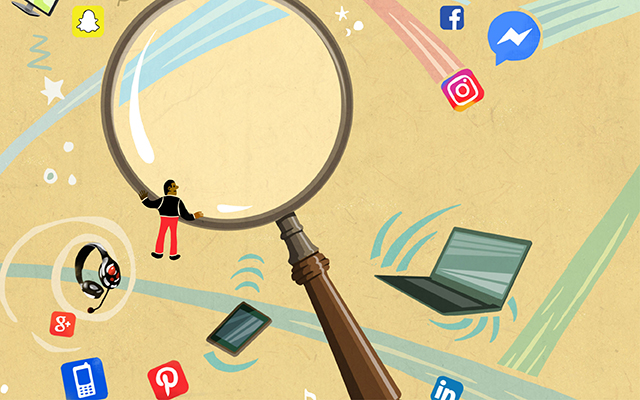Nomophobia, short for “no-mobile phobia,” is a British term coined to describe the fear of being separated from one’s cellphone. It’s not an official pathology (yet), but many can relate.
Most of us persistently check texts, emails, and social media on those tiny screens. And because our phones are rarely far from view, it can feel as if we’re at their constant beck and call. When we’re deep in the throes of our obsession, it can often feel as if our phones are using us.
This is a reasonable concern. We spend a shocking amount of time peering at those screens: Eighty-one percent of Americans own smartphones, and adults spend almost four hours a day looking at them. (This figure is from a 2019 study and doesn’t account for the substantial increase in screen time during the coronavirus pandemic.)
All those hours spent hunched over our screens affect our health: Fingers cramp and hand and forearm muscles ache in conditions known as carpal-tunnel and cubital-tunnel syndromes (a.k.a. “text claw” and “cellphone elbow”); the tendons in our thumbs become inflamed from rubbing on the tunnel surrounding them (“texting thumb,” “trigger thumb”); the neck, back, and shoulders grow stiff and painful from slumping (“text neck” and “cashew posture”).
Oh, and don’t forget eyestrain.
But there’s a better way, at least as far as our bodies are concerned.
Psychologist doreen dodgen-magee (who styles her name in lowercase), PsyD, author of Deviced! Balancing Life and Technology in a Digital World, promotes the importance of the “embodied life” — that is, reclaiming our physical experiences from our devices.
Our “tendency to rely on technology more consistently than our own sense of our mental, emotional, and psychological states has far-reaching consequences,” she notes.
“When we defer more to devices than to physiological impulses or needs, we begin to feel less competent in developing patterns that attend to our actual needs and preferences. We feel best when we feel confident about caring for the body in which we live.”
dodgen-magee is no Luddite; she knows our devices play important roles in our lives. But she believes we can strike a better balance.
If we shift some of our habits, we can live more fully in our bodies while making the most of what our devices have to offer. “Every person has choices when it comes to technology engagement and balancing that with a full, fiery, embodied life,” she says.
She recommends taking some time out of each day to consciously break our phones’ grip on our lives. “If there are routine or scheduled ways that we create for ourselves to break the habits that aren’t painful, that are kind of fun, that can be a help.”
The 18 strategies that follow offer opportunities to break free from our handheld technology.
1. Track your screen time.
Most of us are surprised to learn how much time we spend on our phones. But knowledge is power — and in this context, hopefully, inspiration. With an accurate measure, you can aim to cut your screen time in half over a period of weeks. Here’s how to get started: On an iPhone, go to Settings and select Screen Time. This provides a graph showing how much time you spend on your phone, as well as options for limiting your time on various apps. For those using a Samsung Galaxy, go to Settings, then Digital Wellbeing, then Dashboard, then Screen Time. From there you can see a breakdown of time spent on various apps.
2. Take a conscious phone break.
Put your phone in a drawer with the ringer off for a period of time each day. Rachel Macy Stafford, author of Hands Free Mama, started with 10-minute increments. She now sometimes spends hours or a whole day of unforced phone-free time. “Turn off all your electronics — phone, tablet, laptop, or whatever,” she suggests, “and then put them in a drawer or lock them in a car if you have to.” Devote that time to connecting with loved ones, including yourself: Take a walk, work on a home project, spend time with an old hobby, or learn a new skill. Staring into space is also a good use of break time.
3. Ask for help.
Stafford — who’s also the author of Live Love Now: Relieve the Pressure and Find Real Connection With Our Kids — recommends alerting your loved ones that you’re trying to spend less time on your phone. Tell your family, then set a bounce-back message on your texts and put a note on your social feeds announcing that you’re only checking messages twice a day. Ask for their support or even encourage them to join you.
4. Increase boredom tolerance.
Spend some time just looking out the window or performing a repetitive task like walking laps around your block or even cleaning. It can help retrain your brain to handle more space. This, in turn, can support more creativity. “When you’re bored you are, in reality, opening the gateway to feeding, nurturing, and cultivating your thoughts,” notes Manoush Zomorodi, author of Bored and Brilliant: How Spacing Out Can Unlock Your Most Productive and Creative Self. “Your mind needs boredom to do some of its most important work.” (For more on why downtime is important, see “The Upside of Downtime.”
5. Do a brain dump.
Our brains are buzzing with the stimulation our phones deliver. dodgen-magee recommends trying brain decluttering. Set a timer for 10 minutes and write down everything that comes to mind. Imagine that you are literally removing those thoughts from your mind and freeing space there. Once the timer buzzes, discard the list and turn your attention to a mind free of clutter and distraction.
6. Choose a physical practice that separates you from your phone.
Years ago, dodgen-magee committed to practicing cartwheels in public on Fridays. She didn’t want to attract a crowd, so she watched passersby and waited for the moment when the fewest people would be watching. When cartwheeling, of course, she had to put her phone down. If cartwheels aren’t your thing, try carrying a yo-yo with you everywhere, or drawing in a sketch pad. (For some artistic inspiration, check out “Draw Your Day.”)
7. Take a photo-free day.
When Zomorodi hosted Note to Self on New York public radio, she created the “Bored and Brilliant Project,” a series of challenges designed to inspire boredom — and thus creativity. Challenge No. 3: Do not take photos (or, presumably, videos) for one full day. “It’s OK to be uncomfortable, hostile, or hopefully bored without photos to fill your day,” she writes. “Just use your brain instead of your phone.” Similarly, dodgen-magee suggests taking pictures with your body. “Take in the sights, smells, and sounds around you. Literally imagine your brain downloading the feelings and images this experience holds.”
8. Meditate.
The brain’s prefrontal cortex is “where our ability to be calm and with ourselves . . . is centered,” dodgen-magee explains. And our devices “stimulate almost every part of the brain but that part.” Mindfulness meditation is a powerful tool for breaking the device habit because it increases our ability to choose for ourselves. “Ten minutes of mindfulness meditation a day for four months can double the gray matter in the prefrontal cortex,” she writes.
9. Commit to one hour a day of doing one thing at a time.
Don’t stop to check your phone, dodgen-magee advises. If you’re cooking dinner, just cook dinner; if you’re playing with the dog, just play with the dog. “You will grow your ability to focus massively if you just can commit to that one practice,” she explains.
10. Engage in actual face time.
When dining at a restaurant, leave your phone in your bag or pocket, and devote your full attention to the company at hand. “People with phones make themselves less vulnerable to each other and feel less connected to each other than those who talk without the presence of a phone on the landscape,” explains Sherry Turkle, PhD, founding director of the MIT Initiative for Technology and Self and author of Reclaiming Conversation: The Power of Talk in a Digital Age. Putting the phone facedown doesn’t change this effect: Studies show that the presence of a phone on the table undermines enjoyment and makes conversation partners seem less empathetic.
11. When someone speaks to you, put the phone down.
Too often, we prioritize what’s happening on our phone screens when a live person is asking for our attention. If someone speaks to you when you’re texting or reading on your device, don’t just grunt a response. Offer your full attention and reply with full sentences — even if those include an explanation that you’ll be completely available as soon as you finish writing this work-related text.
12. Delete that app.
Another “Bored and Brilliant” challenge: Delete one app from your phone. You may need to start small, but when you’re ready, make it that game or social-media platform that you know is the biggest time-suck. This doesn’t have to be a strict loss — consider trading in game apps for the 3D version. Scrabble, crossword puzzles, and sudoku were all born and remain available in hands-on forms. Or, if you’re always listening to Spotify, consider visiting some record stores, or revisiting your own stash of vinyl.
13. Keep your phone out of the bedroom.
Looking at your phone at bedtime can hamper a good night’s sleep, and not only because of the screen’s lure. Its blue light suppresses melatonin, stimulating wakefulness and messing with your circadian rhythm. Meanwhile, the all-night dinging of notifications interferes with your all-important REM cycle. Use an actual alarm clock instead of your phone.
14. Find new ways to self-soothe.
We often turn to our devices to distract us from uncomfortable feelings — but this tends to stir us up more. “We need soothing, but we substitute stimulation,” writes dodgen-magee. When something upsets you, she recommends taking a minute to find a quiet spot to engage in some mindful breathing to re-center yourself. You could also try wrapping yourself tightly in a blanket.
15. Get in the flow.
Adopt a hobby that uses your hands and requires focused concentration. Knit, construct a jigsaw puzzle, cook more meals from a cookbook, draw, paint, sculpt. Don’t worry about the end result if you’re new to it. The goal is to give your hands something to do and your brain something to focus on. And it can be immensely satisfying to produce something concrete to show for your time.
16. Do a digital fast.
In his book Digital Minimalism: Choosing a Focused Life in a Noisy World, Cal Newport, PhD, suggests taking a 30-day break from technology. Think of it as an elimination diet: For one month, stop all optional online activities. During this period, plan to spend time engaged in rewarding analog activities like cooking, gardening, or learning to play the guitar. (This is key: Plan how you’re going to fill that newfound time meaningfully.) Then reintroduce optional technologies. “For each technology you introduce,” Newport writes, “determine what value it serves in your life, and how you will use it to maximize this value.”
17. Go camping.
Phones typically don’t work in the wilderness, and you’ll be too busy with survival activities to notice anyway. If you feel you need a GPS phone for safety, designate one person on the trip to be the phone holder, and take it out for emergencies only.
18. Cultivate your physical senses.
Try attending to each of your senses to help neutralize the ongoing intense visual and auditory stimulation of your devices, dodgen-magee suggests.
- Sound: Set aside time to experience as much silence as you can find.
- Sight: Take a walk and look for birds or cloud formations; visit a museum and see some art.
- Smell: Notice how the smell of coffee or a lemon affects you; experiment with some essential oils; grow fragrant plants.
- Taste: Try bold new flavors or completely unseasoned food.
- Touch: Pay attention to texture — hot, cold, rough, smooth, wet, dry, and so on. Use your hands while you’re learning something, like playing a new instrument or knitting. Play with Silly Putty, Kinetic Sand, or a small stone. See how a tactile experience affects your focus. (For more on reengaging the senses, see “Come to Your Senses: Sensory Retreats.”)
Lead By Example
Today’s children and teens are digital natives, having never known a world without cellphones. According to a report by Common Sense Media, tweens spend just under five hours a day on their screens, and teens average just under seven and a half hours.
FOMO (fear of missing out) has become such a common phenomenon that the term is now listed in Merriam-Webster’s dictionary. The feeling has, of course, always existed to some degree, but the all-access pass to the excruciatingly well-edited and curated lives of their peers via social media has elevated it to new levels for kids (and their parents, too). It’s no surprise that FOMO has been linked to lower self-esteem, increased sleep issues, and more anxiety in teens.
Indeed, a study conducted at the University of Pennsylvania found actual causality between social-media use and depression and loneliness among young adults.
Digital devices are amazing tools for school research as well as for connecting with friends, but we now know they have their dark sides. A majority of teens have experienced some form of cyberbullying, and victims are at increased risk for depression, irritability, and anger, and are more likely to smoke, drink, and use drugs.
And cyberbullying isn’t the only downside associated with teens’ tech use. “A lot of the stressors kids talk about in their daily life come from managing their online lives,” explains Rachel Macy Stafford, author of Live Love Now: Relieve the Pressure and Find Real Connection With Our Kids. “When we were teenagers, we had to manage our everyday life, our work, and extracurriculars. They’re managing all of that, plus they have this whole other life — their online life. Many of them talk about not being able to escape from that pressure, that feeling that ‘I’m not enough,’ that ‘I have to respond to everything that’s coming at me.’”
Still, there are ways to help your kids reclaim their time and attention from their devices.
BE THE CHANGE
Modify your own cellphone habits. This is the most important (and hardest) thing you can do. Kids learn by watching.
EMPOWER YOUR KIDS
As you change your own tech behavior, share your struggle with your family. You can even enlist their help. And remember to share what you learn in a nondogmatic way. Stafford recommends talking to kids about technology the same way you would about drugs, alcohol, and sex. It may not seem like they’re listening, but they are.
BE POSITIVE
“We don’t want to be the enforcer who comes in and says, ‘I’m taking away your phone,’” Stafford notes. “That can actually be really traumatic for a young person, because so much of their life is on their phone.” So instead of, “No phones at the dinner table,” she suggests trying a softer, more inviting approach: “Hey guys, we’re not bringing our devices to the table. This is a time for us to talk and be together as a family.”
SET PARAMETERS
“The kids I talk to are telling me they don’t want us to take their phones away, but they do need help managing them,” Stafford notes. As well as maintaining designated phone-free times, she recommends phone-free spaces. “The most damaging place to have your phone, especially for kids, who don’t have the self-control that we do, is in the bedroom.” So designate a place outside the bedrooms for charging at night. All phones might stay in the kitchen, for example. “Then they can tell their friends, ‘Mom and Dad are making me do this. It’s out of my control.’ So, they are not the reason that people can’t get a hold of them. It’s kind of a relief.”




This Post Has 0 Comments